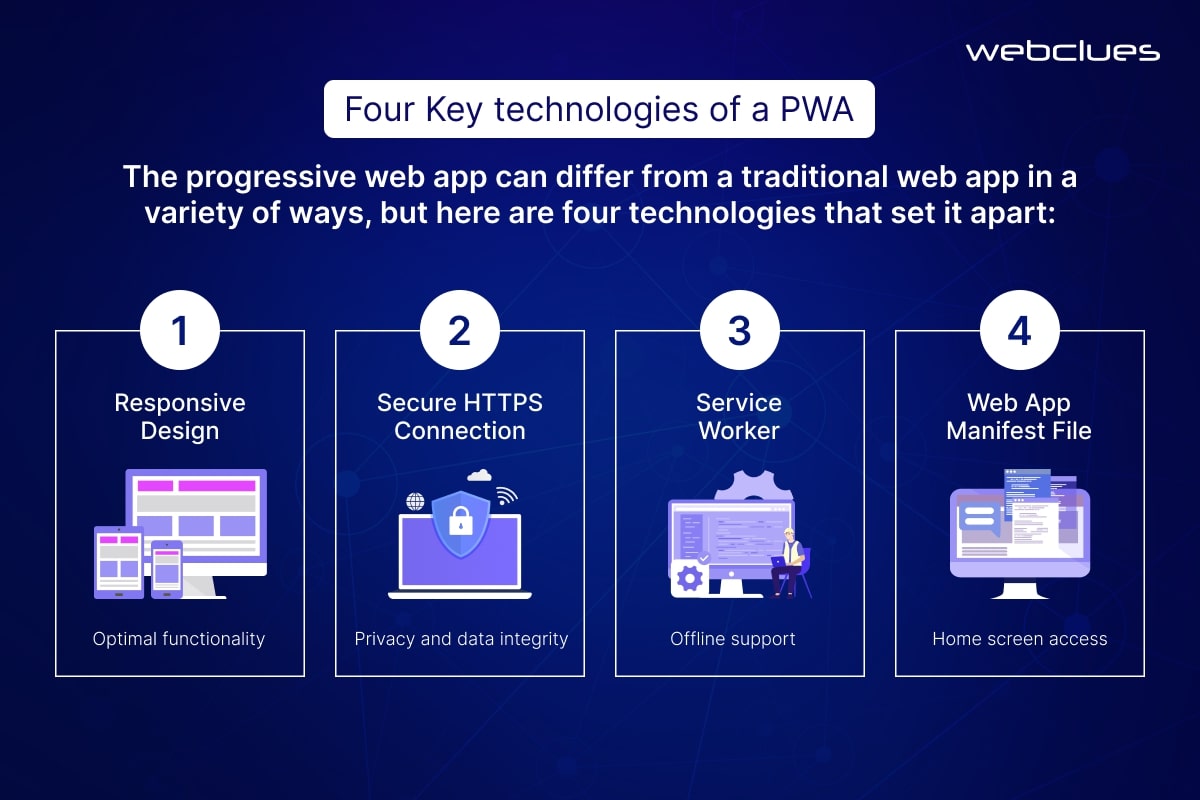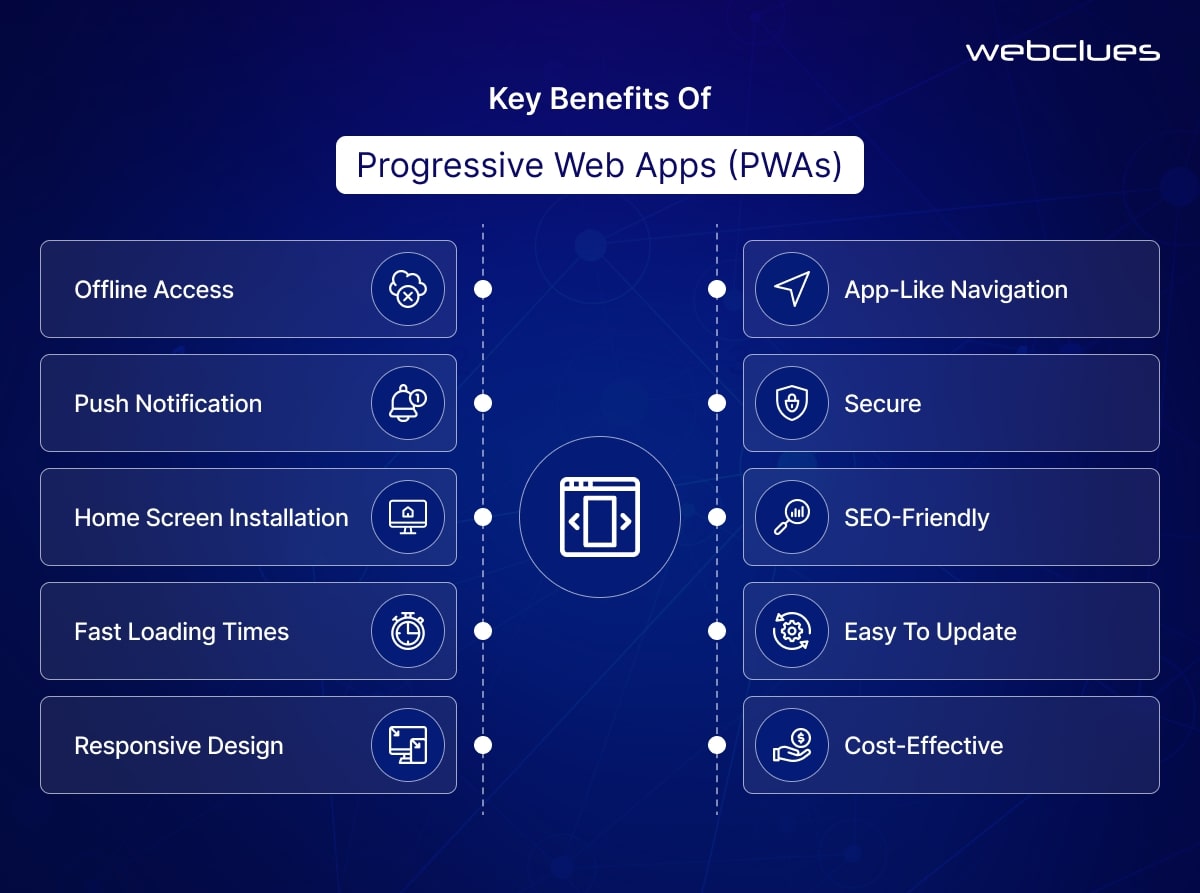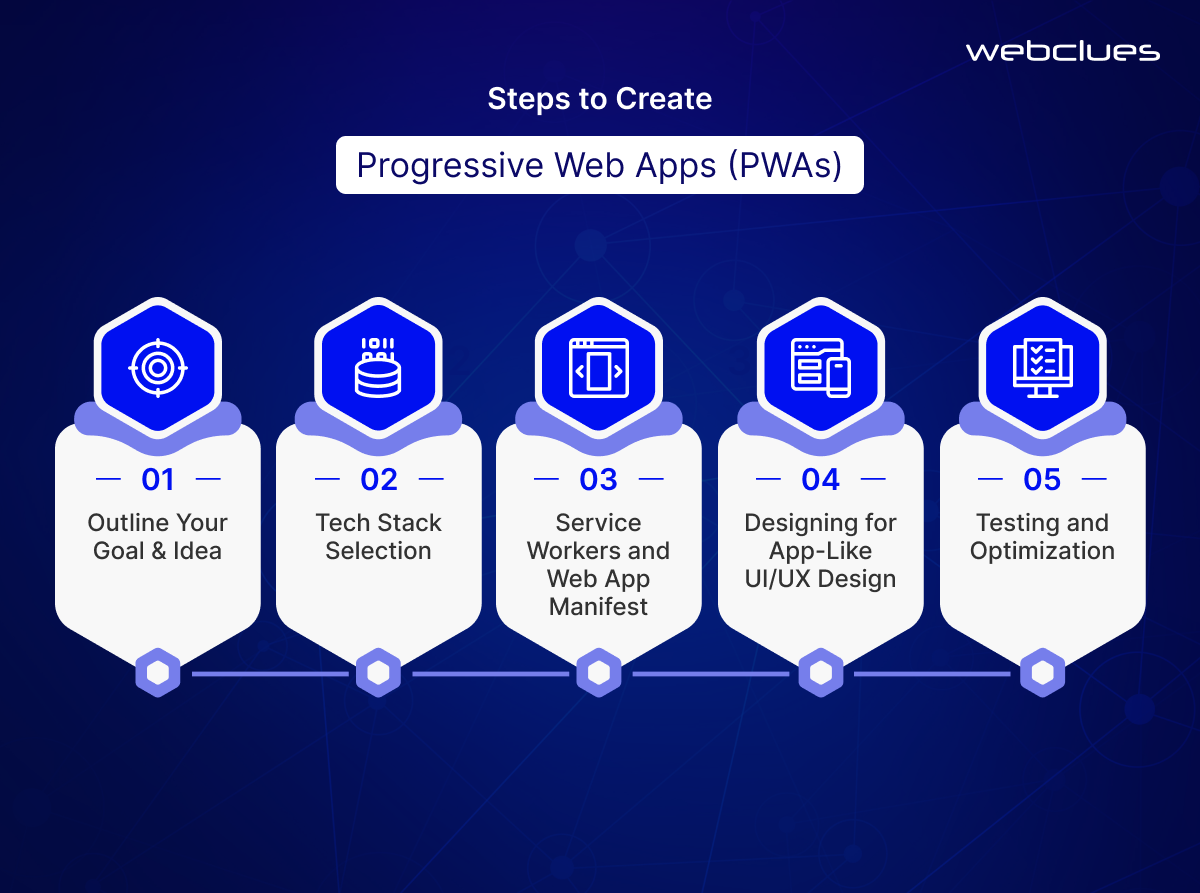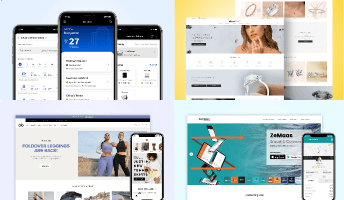The Rise of Progressive Web Apps (PWAs): Offering a Native App Experience on the Web
.jpg)
As of May 2024, a staggering 62.15% of the global market share for web browsing now belongs to smartphones and tablets [Source: Statcounter]. This shift in user behavior has led to the rise of mobile apps, offering a convenient and personalized way to interact with everything from social media to banking.
However, even with app stores overflowing with options, users face challenges. Discovering the perfect app can be cumbersome with countless options vying for limited screen space and attention. Furthermore, app size can be a major obstacle. Downloading hefty apps can consume a lot of storage space, especially on older devices. Moreover, dependence on app stores creates a barrier to entry, leaving valuable functionalities undiscovered by users who simply don’t come across the right app.
Progressive Web Apps (PWAs) offer a plausible solution to these challenges. PWAs bridge the gap between the convenience and functionality of native apps and the accessibility and discoverability of the web. They offer an app-like experience directly through your web browser, eliminating the need for app store downloads and hefty storage requirements.
What are Progressive Web Apps (PWAs)?
Progressive Web Apps (PWAs) are web applications that provide a native app-like experience to users. They combine the best of both worlds, offering an app-like experience accessible directly through your web browser. But what exactly makes them "progressive"?
Web development companies build PWAs on the principle of progressive enhancement. This means they start as basic web pages that work flawlessly on any browser, and then progressively add features and functionalities based on the capabilities of the device and browser being used. This results in a smooth experience for everyone, regardless of their device or internet connection.
At the core of a PWA are several key functionalities that facilitate its native app-like capabilities.

- Service Workers
These act as invisible behind-the-scenes helpers, offering features like offline functionality and push notifications. Service workers essentially pre-cache essential app content, allowing users to interact with the PWA even without an internet connection. Additionally, they act as a communication channel, facilitating push notifications to keep users updated on relevant information.
- Web App Manifest
This acts as a blueprint for your PWA, providing essential information like app name, icons, and splash screens. Essentially, the web app manifest is a JSON file that contains metadata about the PWA, such as its name, icons, and splash screens. The Web App Manifest also plays a crucial role in allowing users to install the PWA on their home screen, creating a native app-like experience.
- Secure HTTPS Connection
PWAs use HTTPS to facilitate the secure transmission of data between the user's device and the server. This not only protects user data but also improves the overall security and trustworthiness of the PWA.
- Responsive Design
PWAs are designed to be responsive, meaning they adapt to different screen sizes and devices. This makes sure that the PWA looks and functions optimally across various devices, from smartphones to desktop computers.
Why Are PWAs Gaining Traction?
Progressive Web Apps (PWAs) are gaining traction due to their ability to provide a smooth and high-quality user experience, while also offering significant business advantages. Here are some key reasons why PWAs are becoming increasingly popular.

User Benefits
- Fast Loading Times: PWAs load quickly, even with limited connectivity. This enables users to access the content they need without delay. This is particularly important for users in areas with slow internet speeds or limited data plans. By utilizing the browser's caching capabilities, PWAs can load content rapidly, reducing the time it takes for users to access the information they need.
- Installation-Free Access: PWAs work directly from the browser, eliminating the need for users to download and install an app. This makes it easy for users to access the content they need without having to skim through app stores or deal with the hassle of installing and updating apps. Additionally, PWAs can be easily shared and accessed across multiple devices, making it simple for users to access their favorite content on the go.
- Push Notifications: PWAs can send push notifications, facilitating real-time engagement and keeping users informed about updates and new content. This feature allows developers to re-engage users and provide timely updates, increasing user retention and driving more conversions. Push notifications can also be used to provide important updates, such as weather alerts or news notifications, keeping users informed and up-to-date.
- Offline Functionality: PWAs can function offline, providing an uninterrupted user experience even in areas with limited or no internet connectivity. This is particularly important for users who need to access critical information or complete tasks offline, such as workers in remote areas or travelers without reliable internet access. By providing offline functionality, PWAs can ensure that users can access the content they need, even when the internet is unavailable.
Business Benefits
- Wider Reach: PWAs bypass app store limitations, allowing developers to reach a broader audience and increase their user base. This is particularly important for developers who want to reach users in areas with limited app store availability or for those who want to avoid the costs and complexities associated with app store distribution. By leveraging the web, PWAs can reach users across multiple platforms and devices, increasing their potential user base.
- Reduced Development Costs: PWA web app development can be considerably cheaper than creating a native app, as it requires only a single codebase for all platforms. This reduces the costs of web app development, testing, and maintaining multiple apps for different platforms. Furthermore, PWAs can be easily updated and maintained, reducing the costs associated with app updates and maintenance.
- Easier Maintenance: PWAs have a single codebase, making maintenance and updates easier and more efficient. This reduces the complexity and costs associated with maintaining multiple apps for different platforms. By having a single codebase, developers can easily update and maintain their PWA so that users always have access to the latest features and updates.
- Improved SEO: Content remains discoverable by search engines, which improves the PWA’s visibility and search engine ranking. This is especially beneficial for developers who want to increase their online visibility and drive more organic traffic to their PWA. By optimizing their PWA for search engines, developers can increase their visibility and drive conversions.
Use Cases for PWAs
PWAs aren't confined to a singular niche. Their versatility extends across various industries, offering unique advantages to both users and businesses.
E-commerce and Online Shopping
PWAs can notably improve the e-commerce experience by providing a fast, secure, and engaging platform for users to shop online.
- Faster Checkout and Reduced Cart Abandonment: PWAs provide a smooth and speedy shopping experience, even on slower connections. This leads to quicker checkouts and reduced cart abandonment rates, boosting sales conversions.
- Personalized Experience: PWAs can provide a personalized experience for users, allowing them to save their preferences and receive personalized recommendations.
- Offline product browsing and Wishlist creation: Service workers allow users to browse product catalogs and add items to wishlists even when offline, leading to a smoother shopping experience.
Examples of successful e-commerce PWAs
Twitter Lite: Twitter's PWA has seen a 20% increase in user engagement and a 70% reduction in data usage. [Source]
Lancôme: Lancôme's PWA achieved a significant increase in sessions (73%) and a substantial reduction in bounce rate (53%). [Source]
News and Media
PWAs can also improve the news and media experience by making sure users stay informed and engaged with the latest happenings.
- Interactive Content and Multimedia: PWAs can incorporate interactive elements like quizzes, polls, or embedded audio clips within news articles, making the content more engaging and encouraging user participation.
- Personalized News Feeds: Utilizing user preferences and browsing history, PWAs can curate personalized news feeds, making sure users see the stories that matter most to them. This level of customization keeps users engaged and coming back for more.
- Subscription Management and Paywalls: PWAs can optimize the subscription process for premium news content, offering a smooth user experience for paid memberships or paywalled articles.
Example:
The Guardian PWA: This renowned news platform utilizes PWAs to deliver a rich and interactive news experience with personalized feeds and offline functionality. This has resulted in a more engaged readership and increased user satisfaction.
Gaming
PWAs have expanded their reach to gaming applications. They offer a novel and exciting platform for gamers and developers.
- Cloud Gaming with Reduced Latency: PWAs can integrate with cloud gaming services, allowing users to play high-end games directly within the browser without needing powerful devices. This leads to a wider audience who can experience high-quality gaming without hefty downloads.
- Social Features and Community Building: PWAs can incorporate social features like leaderboards, chat functionalities, or in-game communities. This creates a sense of connection among players, promoting user engagement and loyalty.
- Progressive Downloading of Game Assets: PWAs can facilitate progressive downloading of game assets, allowing users to start playing with a minimal download and then gradually download additional content in the background. This reduces initial load times and improves accessibility for users with limited data plans.
Example:
Genshin Impact Web (PC & Mobile): This open-world action RPG utilizes a PWA approach on PC and mobile devices. It offers a high-quality gaming experience with cloud streaming functionalities, allowing players to jump in without massive downloads. Additionally, it creates a sense of community through its interactive features.
How to Build Your Own PWA
Building a Progressive Web App (PWA) requires a strategic approach to development. Here's a simplified breakdown of the development process to get you started.

Tech Stack Selection
The first step involves choosing the right tools for the job. Popular frameworks like React, Angular, or Vue.js provide a solid foundation for building dynamic and interactive PWA experiences. These frameworks offer features like component-based architecture, state management, and streamlined development workflows.
Consider the following factors when selecting a tech stack:
- Performance: Choose a framework that provides efficient rendering and caching capabilities.
- Scalability: Select a framework that can handle large amounts of traffic and data.
- Ease of Use: Opt for a framework with a user-friendly interface and extensive documentation.
Service Workers and Web App Manifest
These are the foundations of PWA functionality. You'll need to implement service workers to facilitate offline capabilities and push notifications. Additionally, creating a Web App Manifest defines essential information about your PWA, including its name, icons, and splash screens. This manifest plays a crucial role in instigating app installation and a native-like experience on user devices.
Designing for App-Like UI/UX Design
To provide a smooth and engaging user experience, focus on designing your PWA with an app-like interface. Consider the following best practices:
- Responsive Design: Make sure your PWA is responsive and adapts to different screen sizes and devices.
- Material Design: Use Material Design principles to create a visually appealing and intuitive interface.
- Accessibility: Implement accessibility features to ensure your PWA is usable by all users.
Testing and Optimization
Testing and optimization are crucial steps in the PWA development process. Follow the following steps to make sure your PWA works efficiently across various devices and browsers.
- Testing for Different Devices: Test your PWA on different devices, including smartphones, tablets, and desktops.
- Testing for Different Browsers: Test your PWA on different browsers, including Google Chrome, Mozilla Firefox, and Safari.
- Optimizing for Performance: Optimize your PWA for performance by reducing file sizes, utilizing caching, and implementing lazy loading.
The Future is Progressive
PWA development is updating rapidly, with new advancements coming up all the time. For instance, WebAssembly (WASM) allows PWAs to handle even heavier functionalities typically associated with native apps. Furthermore, WASM facilitates complex games, graphics-intensive experiences, and advanced features. This leads to richer and more complex user experiences within the PWA framework.
As PWAs bridge the gap between web and mobile app experiences, they present an exciting opportunity for businesses to reach wider audiences and boost user engagement. Whether you're looking to create a new mobile touchpoint for your brand or revamp an existing web app, PWAs are definitely worth considering.
At WebClues Infotech, we have extensive expertise in PWA development and are dedicated to helping our clients create innovative and effective mobile solutions. If you are interested in learning more about our PWA development services or would like to discuss how PWAs can benefit your next mobile project, please do not hesitate to contact us.
Build Your Agile Team
Hire Skilled Developer From Us
Transform your web presence with a Progressive Web App from WebClues.
Using modern web technologies, we develop PWAs that function like native apps—without costly development overhead. Optimize performance, engagement, and usability while reaching users across devices with a single codebase.
Get a Quote!Our Recent Blogs
Sharing knowledge helps us grow, stay motivated and stay on-track with frontier technological and design concepts. Developers and business innovators, customers and employees - our events are all about you.
Contact
Information
Whether you're building next door or across time zones, we stay close in ideas, in execution, and in support.
India

Ahmedabad
1007-1010, Signature-1,
S.G.Highway, Makarba,
Ahmedabad, Gujarat - 380051
Rajkot
1308 - The Spire, 150 Feet Ring Rd,
Manharpura 1, Madhapar, Rajkot, Gujarat - 360007
UAE
Dubai
Dubai Silicon Oasis, DDP,
Building A1, Dubai, UAE
USA
Atlanta
6851 Roswell Rd 2nd Floor, Atlanta, GA, USA 30328
New Jersey
513 Baldwin Ave, Jersey City,
NJ 07306, USA
California
4701 Patrick Henry Dr. Building
26 Santa Clara, California 95054
Australia
Queensland
120 Highgate Street, Coopers Plains, Brisbane, Queensland 4108
UK
London
85 Great Portland Street, First
Floor, London, W1W 7LT
Canada
Burlington
5096 South Service Rd,
ON Burlington, L7l 4X4
Let’s Transform Your Idea into Reality. Get in Touch





